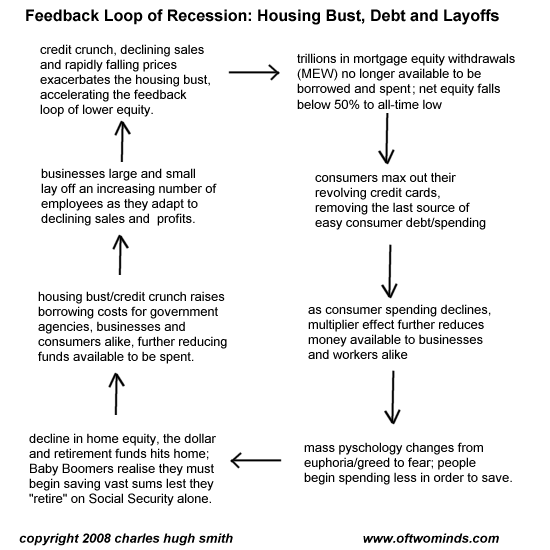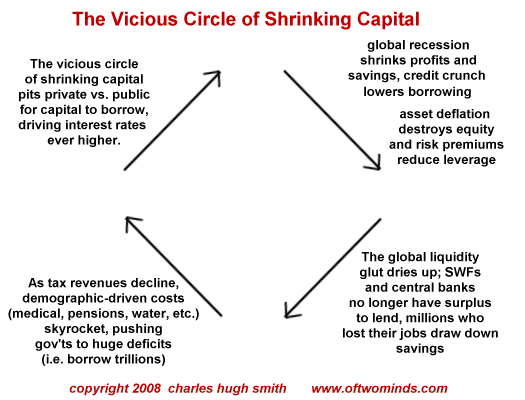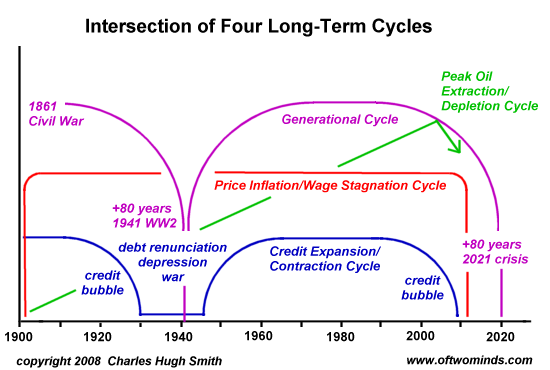Things Fall Apart: But Not Just Yet
Courtesy of Charles Hugh Smith, Of Two Minds
Even as the global financial system becomes ever more fragile and vulnerable to distruption, feedback loops will maintain the Status Quo for awhile longer.
The best analogy to describe the global financial system may well be "skating on thin ice." Despite all the "fixes" and "reforms," the ice continues thinning for a variety of reasons which are not fixable in the current State/Plutocracy-dominated Status Quo: massive overindebtedness, both public and private, and a declining ability to service that ever-rising debt.
Thus it is natural for many observers to see the current crisis-du-jour (Gulf oil well blowout, China’s real estate bubble, sovereign debt/banking insolvency in Europe, etc.) as the "straw that will break the camel’s back," that is, the crisis which will trigger a phase transition or tipping point to the global collapse which is already inevitable: demographics, exponential debt and resource depletion all render the status quo Neoliberal Capitalist Globalized system unsustainable.
The concepts of phase transition and the related "stick-slip hypothesis" play key parts in the Survival+ critique, as they describe the process of a system reaching a "critical point": the sand pile suddenly cascades, tectonic plates shift, causing an earthquake, or the buying of bundled debt (such as mortgage-backed securities) suddenly drops to near-zero.
But other forces are constantly striving to maintain the Status Quo, and as such they resist the dynamics pressing the global financial system to the breaking point. These are negative feedback loops, and the major Central States have deployed powerful monetary and political tools to stave off collapse.
Here is a diagram of a positive feedback loop in which recession reduces housing equity which then further reinforces recession, which further depresses housing, and so on:

This chart illustrates how capital declines feed additional declines:

At the critical point, the positive feedback overwhelms the negative feedback and a death spiral ensues. This diagram charts how raising taxes in a contracting economy to feed public unions and other tax-dependent fiefdoms creates a "death spiral" which ends in the bankruptcy of local government.

But the last two years have shown how those with enormous stakes in maintaining the Status Quo have thrown all their resources into staving off or deflecting the crises. The Full-Spectrum Defense of the Status Quo is generally a facsmile of reform, a facade of "change" heralded as the "fix" to all our most pressing problems, or merely propaganda, i.e. a travesty of a mockery of a sham.
Nonetheless, we would do well not to underestimate the tenaciousness and reserves of those benefiting from the Status Quo, or the depth of their commitment to doing whatever it takes to defend their perquisites and power.
But in addition to feedback loops, there are also long-wave cycles which have tended to play out over history. Nothing is written in stone, of course, except the endless repetition of human folly, and thus those who dismiss all cycles as mesaningless do so at their peril.
This chart from Weblogs & New Media: Marketing in Crisis illustrates four primary cycles which are set to coincide in the 2010-2022 time frame:
1. The 80-year ( four-generation) cycle of U.S. history–a major transformative crisis occurs about every 80 years (1781, 1861, 1941, 2021), as described in The Fourth Turning.
2. The Fisher wage stagnation/price inflation cycle documented by David Hackett Fischer in The Great Wave: Price Revolutions and the Rhythm of History; (no precise length, but wages have stagnated and prices have been rising since the early 1970s)
3. The credit expansion/bubble-bust cycle (i.e. the Kondratieff cycle)
4. The depletion of oil and other non-renewable resources (lithium, uranium, etc.; see The Long Emergency: Surviving the End of Oil, Climate Change, and Other Converging Catastrophes of the Twenty-First Century and Financial Armageddon: Protecting Your Future from Four Impending Catastrophes)
As a lagniappe, there is fifth cycle possibility conjectured by Elliott Wave Theory, the Grand Supercycle (not shown), the last of which led to the 1720 South Sea Bubble collapsing and a 50-year long depression, and a sixth relating to warfare, as wars also tend to cycle, as shown in The Rhythm of War (recommended).
As an example of how Status Quo resistance/feedback loops can lengthen the unsustainable longer than seems possible: many of us knew housing was in massive bubble as early as late 2003, yet the bubble continued expanding for over 3 years, finally popping in early 2007. The insolvent black hole known as Fannie Mae continued sporting a share of price of $65-$70, even as its obvious value was near-zero. (I know, because I lost a lot of money betting that the supposedly infallible "market" would eventually pole-axe the fraudulent Fannie’s share price. The value of Fannie’s shares didn’t fall until the entire house of cards was in full-blown collapse.)
Thus I fully expect the U.S. Central State to continue borrowing and squandering $1.5 trillion a year to maintain the Status Quo and the American Empire, with few if any visible consequences, as the Chinese Central State and other exporting nations will desperately continue propping up low interest rates to keep their mercantilist fantasies (that the U.S. will continue to be the dumping ground for the world’s massive oversupply of exports) alive for another year.
The Fed will persist in its manipulations and machinations to prop up the housing market and the stock market, as those facades are the critical elements in the propaganda campaign to convince the fast-crumbling middle-class that all is well and the Plutocracy is not only firmly in charge, but it’s doing a darned fine job of it.
But the heat of insolvency is not dissipating, as much as it is merely being cloaked; the ice is thinning every day, and the global financial system is becoming more brittle, more fragile, more vulnerable, more unstable and less resilient. Meanwhile, obfuscation, misdirection, and outright propaganda have been normalized as "news," the illegitimate (shadow banking, shadow National Security State, etc.) have been legitimized and those who challenge the Status Quo or act as whistleblowers are quickly discredited or marginalized.
My best guess: the wheels won’t really fall off the wobbly global cart until 2012-2013, with the possibility that it all hangs together (against ever-longer odds) until 2014. After a near-collapse experience, things will seem to improve for a few years, setting up the real collapse in the 2020-2022 time frame. Just a guess…to be revised as events unfold.



